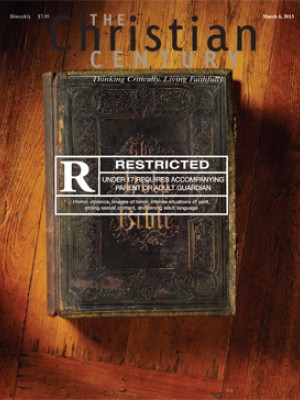Sunday, March 17, 2013: John 12:1-8
When our congregation celebrates communion by intinction, the pastor invites members to “Come. Take off a large piece of bread. See how large and great God’s love is for you. Dip your bread into the cup.” The congregation then responds with “Thanks be to God.”
The pastor’s words are pedagogical and practical. Big pieces of bread keep fingers out of the cup, while the response teaches people to speak gratitude.
Surely the celebration included a “Thanks be to God” when Martha, Mary and Lazarus sat down to dinner with Jesus. The sisters had accepted that their brother was dead; they had seen Christ weep openly for him. Then suddenly they heard the words, “Unbind him and let him go.”
Read our latest issue or browse back issues.
I feel some of this joy and hope when we celebrate communion by intinction. As people around me partake of the bread and wine, I grieve for those who’ve died and left empty places in the pews. I see a line of people rise from their seats and pray for those who are widows and widowers. I rejoice to see a young confirmand walk behind one of the widows, then reach out and place his hand on her shoulder.
After the last person has been served and one of us pastors speaks the blessing, the striking reality of God’s ability to break into human brokenness fills my heart and the entire room with the fragrance of God’s loving mercy. I trust that we are bound together with Mary, the woman who anointed Jesus and filled another room with love’s aroma.
In our church, laypeople assist the clergy as members of the congregation move toward the Lord’s table. One Sunday, Ted was my serving companion. A rhythm was established as people in line moved, one by one, to the next available station. I read the name tag of the person standing in front of me and said, “Joseph, this is Christ’s body, broken for you.” Then Ted added, “And, Joseph, the cup of life.” Joseph responded, “Thanks be to God.”
A visitor without a name tag came up to us. He took bread from the loaf I was holding and moved on to where Ted stood with the cup. Suddenly I heard Ted say, “Whoa there, cowboy—we don’t do it that way here.” Instead of dipping his bread into the cup, the visitor was leaning in to drink from it. I continued on to the next person in line, but Ted’s words stayed in my head: “Whoa there, cowboy—we don’t do it that way here.”
Ted’s admonition wasn’t meant as a rejection. His words were more of an inner thought spontaneously verbalized—a humorous and genuine reaction to the unexpected. But hopefully the visitor was not kept from the holiness of communion: he was, after all, leaning in to the cup out of some longing to be there and to know Christ.
We all need to know Christ. I’ve learned to trust that the disciplined practice of coming to table, along with the memory of recent and long-past celebrations of the sacrament, guides my life of faith by preparing me for the beauty found in an ordinary day’s crisis and chaos.
Maybe it’s the practices established in my childhood church that pull me in. In those days of liturgical renewal we gathered around the table in a circle, passing the loaf, one generation saying to another, “This is Christ’s body broken for you.”
My parents, who came down from the choir to join us at the table, taught me, “Annie, this is a family affair—bigger than just us—but this is what we do and central to who we are. This is what it means to be at home.”
Maybe it’s that I’m being fed by eucharistic practices that have yet to become traditions. Once a month we’re testing a contemporary service in our fellowship hall. It’s called the Festival, and at it we proclaim the word, set the table, sing songs and ask children to help gather up written prayers of the people. We lay down a carpet to absorb some of the reverb of the drums and set laptops on the baby grand—all of this a departure from more formal Sunday services. We’ve learned simple things, like not to set the bread directly in front of the speakers, and harder things, like how to accept that it takes time, patience and wisdom to change an institution.
We’re learning more nuanced things too, like the importance of hearing the voices of those who are searching for God and trying to connect with God. For some, this meal is the only place where they have a place at the table, where they find home.
Jesus’ affirmation of Mary’s gift paves the way for us to love others. As we move to and from the table we learn to trust in God’s faithfulness. With God’s help, we mimic those patterns of movement, getting up and getting out, praying and moving, making a way for all to find home.





